Documenting your geodatabase design is important. At the ArcGIS data models Web site (https://support.esri.com/datamodels), a series of diagrams is used to represent the key design concepts and document the specifications of geodatabase elements, metadata, and map layers in each of the data model templates. This section provides a short overview for how various geodatabase elements are presented at the Web site and may be helpful as you document your own designs.
There are six key elements to represent the contents of your geodatabase design. These include the following:
- Datasets—These are specifications for how to record the properties of feature classes, rasters, and attribute tables as well as the set of columns in each table. For spatial representations, you'll see some geometric properties (such as point, line, and polygon and types of coordinates). Often, you'll see a specification for subtypes. These parts of the schema diagram are always shown in blue.
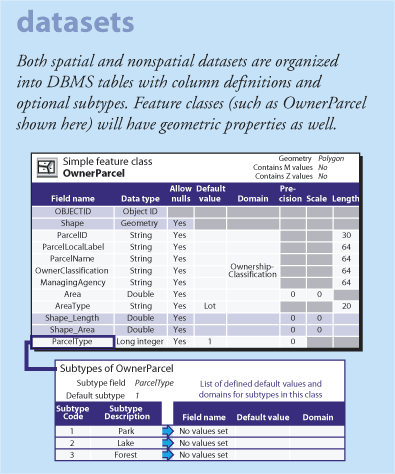
- Relationship classes—Attribute relationships are widely used in GIS, just as they are in all DBMS applications. They define how rows in one table can be associated with rows in another table. Relationships have a direction of cardinality and other properties (for example, is this a one-to-one, one-to-many, or many-to-many relationship?). Relationships and their properties are shown in green.

- Domains—These represent the list or range of valid values for attribute columns. These rules control how the software maintains data integrity in certain attribute columns. Domains are shown in red.
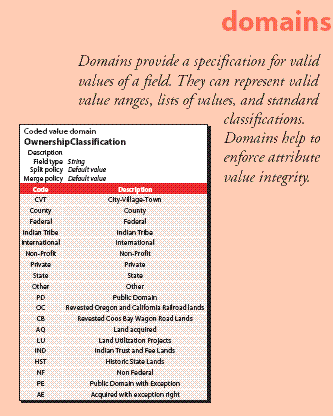
-
Spatial relationships and spatial rules— A number of advanced data modeling capabilities are available for geodatabases. For example, data elements, such as topologies and their properties, are used to model how features share geometry with other features. Topologies, along with network datasets, address locators, terrains, cartographic representations, geometric networks, and many other advanced geodatabase types, provide a critical and widely used GIS mechanism to enable spatial behaviors and enforce integrity in GIS databases. These and other rules, such as networks, are shown in orange.
The best way to think about how to document and describe the set of extended data types in the geodatabase is to describe their rules and the behaviors of the spatial relationships. The following is an example of how a topology can be documented:
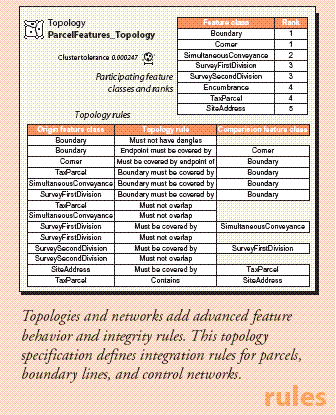
- Map layers—GIS includes interactive maps and other views. A critical part of each dataset is the specification for how it is symbolized and rendered in maps. These are typically defined as layer properties in ArcMap and specify how features are assigned map symbology (colors, fill patterns, line and point symbols) and text labels. Layers are not managed in geodatabases but are an important aspect in helping to define some key dataset properties in a geodatabase schema. Layer specifications are shown in yellow. Layers can be stored as .lyr files or as elements in an ArcMap document (.mxd).
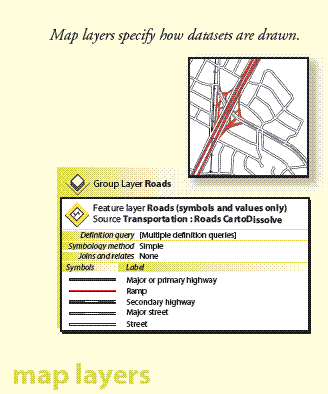
- 2D and 3D basemaps—Define the fundamental basemap displays and determine if this data theme will be used in these interactive map displays. If this is the case, it is important to define the set of map scales for your basemaps and the map display properties at each map scale. You'll essentially define a different map specification for each map scale and define map layers for each scale.
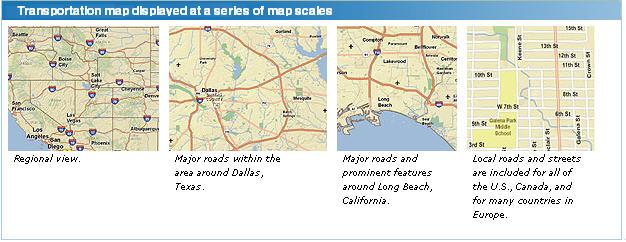
Documenting additional properties of your geodatabase design
Other key properties of your geodatabase design should be considered and documented including
- The definition of your coordinate system and spatial properties for each dataset
This includes such properties as the map projection; coordinate system; spheroid; datum; x,y units; vertical coordinate system; and the use of z and m properties.
- Key tolerances and the coordinate resolution for each dataset
- The data sources and data compilation workflows
This includes translation scripts, geoprocessing and transformation models, and the workflows used to build and maintain the dataset.
- Metadata documentation for each dataset